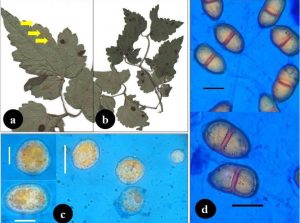Puccinia himachalensis A.K. Gautam & S. Avasthi, sp. nov., Index Fungorum number: IF 818695
Etymology: The species epithet himachalensis is named for the state from where sample collected (Himachal Pradesh, India).
Uredinia mainly hypophyllous, with lightly chlorotic tissue on the corresponding upper surface, solitary or in groups, subepidermal, erumpent, orange. Urediniospores ovoid or more or less globose, yellowish orange, 20–47 × 16.5–47 [x̅ = 27.2 (±7.0) × 21.4 (± 8.0), n = 30] μm, wall 1–3.3 µm thick. Telia amphigenous, erumpent, brown to black. Teliospores 2-celled, light to dark brown with light violet to chestnut brown coloured septum, oblong to oblong-clavate, rounded at both ends, not or slightly constricted at septum, 39.5–53 × 21–27.5 [x̅ = 44.2 (± 3.19) × 23.0 (± 1.75), n = 25] μm; wall 2–3.5 µm thick at sides, 2.5–4.5 µm thick at apex, brown; germ pore of upper cell apical or usually depressed, pore of lower cell near septum; pedicels colourless, 23–67 (24.25 ±1.35) µm long.
Known distribution: Mandi, Himachal Pradesh, India.
Material examined: INDIA, Himachal Pradesh, Mandi, 760 m, on leaves of Clematis grata, 14 November 2013, Ajay Kumar Gautam (AUMH 1032, holotype).
Notes: The rust fungus examined in the present study has ovoid to globose, unicellular urediniospores and two-celled teliospores which revealed that fungus taxonomically falls under genus Puccinia. Five species of Puccinia have been recorded on Clematis spp.: P. wattiana Barclay, P. ustalis Berk., P. clematidicola Tai, P. atragenes Hausmann, and P. exhausta Dietel (Table 1; Zhuang et al. 1991). After comparison with all, a close resemblance was seen with P. wattiana. In P. wattiana the telia form in more or less concentric circles whereas they are scattered and single in the new species. The teliospores of P. himachalensis are larger than in P. wattiana (39.5–53 × 21–27.5 µm versus 30–48 × 18–25 µm). A light violet to chestnut brown colouration was observed in septa of teliospores which also supports the distinction of present taxa from P. wattiana. The size of the pedicel is also variable as compared to P. wattiana. Therefore, it is justified to introduce a new species of Puccinia.
Fig. 1 Puccinia himachalensis. a Uredinia (arrowed). b Telia. c Uredinospores. d Teliospores. Scale bars c = 10 μm; d = 20 μm.

